丝裂霉素C (培养级),Mitomycin C (cell culture tested)
产品编号:Sigma-M4287| CAS NO:50-07-7| MDL NO:MFCD00078109| 分子式:C15H18N4O5| 分子量:334.33
Mitomycin C 是一种抗肿瘤类抗生素,通过阻断DNA合成抑制多种肿瘤细胞。Mitomycin C通过诱导DNA链间交联,物理性阻断DNA复制,重组和RNA转录。Mitomycin C增强TRAIL-诱导的HCT116 (p53-/-)结肠癌细胞的凋亡,并通过死亡受体不依赖于JNK的上调使耐TRAIL的结肠癌细胞HT-29对细胞因子敏感。Mitomycin C 还是一种 ADC 毒性分子 (ADC Cytotoxin),可以诱导凋亡 (Apoptosis) 作用。
本网站销售的所有产品仅用于工业应用或者科学研究等非医疗目的,不可用于人类或动物的临床诊断或者治疗,非药用,非食用,
| 产品名称 | 丝裂霉素C (培养级) | ||||||||||||||||
|---|---|---|---|---|---|---|---|---|---|---|---|---|---|---|---|---|---|
| 英文名称 | Mitomycin C (cell culture tested) | ||||||||||||||||
| CAS编号 | 50-07-7 | ||||||||||||||||
| 产品描述 | Mitomycin C 是一种抗肿瘤类抗生素,通过阻断DNA合成抑制多种肿瘤细胞。Mitomycin C通过诱导DNA链间交联,物理性阻断DNA复制,重组和RNA转录。Mitomycin C增强TRAIL-诱导的HCT116 (p53-/-)结肠癌细胞的凋亡,并通过死亡受体不依赖于JNK的上调使耐TRAIL的结肠癌细胞HT-29对细胞因子敏感。Mitomycin C 还是一种 ADC 毒性分子 (ADC Cytotoxin),可以诱导凋亡 (Apoptosis) 作用。 | ||||||||||||||||
| 产品熔点 | 360 °C | ||||||||||||||||
| 产品沸点 | 532.0±60.0 °C at 760 mmHg | ||||||||||||||||
| 产品密度 | 1.9±0.1 g/cm3 | ||||||||||||||||
| 产品闪点 | 275.5±32.9 °C | ||||||||||||||||
| 精确质量 | 334.127716 | ||||||||||||||||
| PSA | 146.89000 | ||||||||||||||||
| LogP | -0.27 | ||||||||||||||||
| 外观性状 | 暗蓝色灰色结晶粉末 | ||||||||||||||||
| 蒸气压 | 0.0±3.2 mmHg at 25°C | ||||||||||||||||
| 折射率 | 1.828 | ||||||||||||||||
| 溶解性 | soluble | ||||||||||||||||
| 溶解性数据 | In Vitro:
DMSO : 50 mg/mL (149.55 mM; Need ultrasonic) H2O : < 0.1 mg/mL (ultrasonic;warming;heat to 60°C) (insoluble) 配制储备液
*
请根据产品在不同溶剂中的溶解度选择合适的溶剂配制储备液;一旦配成溶液,请分装保存,避免反复冻融造成的产品失效。 In Vivo:
请根据您的实验动物和给药方式选择适当的溶解方案。以下溶解方案都请先按照 In Vitro 方式配制澄清的储备液,再依次添加助溶剂:
——为保证实验结果的可靠性,澄清的储备液可以根据储存条件,适当保存;体内实验的工作液,建议您现用现配,当天使用;
以下溶剂前显示的百
| ||||||||||||||||
| 靶点 |
DNA synthesis | ||||||||||||||||
| 体外研究 | HCT116(p53 - / - )细胞对丝裂霉素C或单独的TRAIL最不敏感。然而,令人惊讶的是,用MMC和TRAIL的组合处理显着降低了细胞活力。尽管单独的丝裂霉素C和TRAIL是中等有效的,但丝裂霉素C显着增强TRAIL对抑制细胞增殖的作用。单独的丝裂霉素C和TRAIL处理分别诱导9.5%和35.0%的细胞凋亡。然而,用丝裂霉素C和TRAIL联合治疗可使细胞凋亡增加至66.6%。丝裂霉素C是一种细胞毒性化学治疗剂,以DNA交联形式引起DNA损伤以及各种DNA单加合物,已知可诱导p53 。 | ||||||||||||||||
| 体内研究 | 每隔一天用丝裂霉素C(ip,1mg / kg)和TRAIL(iv,100μg)处理携带异种移植的HCT116(p53 - / - )结肠肿瘤和HT-29结肠肿瘤的小鼠。用联合治疗方案的10个连续周期治疗动物。联合疗法显着抑制肿瘤生长,并且不影响小鼠的体重,表明丝裂霉素C和TRAIL的治疗组合具有良好的耐受性并且在体内具有抗肿瘤活性。膀胱内丝裂霉素C滴注对体重有影响,这在正常,NaCl滴注或表阿霉素滴注的大鼠中未观察到。连续3次每周滴注1mg / mL丝裂霉素C几乎没有体重增加,而其他3组中的大鼠与MMC治疗的大鼠相比具有统计学上显着的体重增加。 | ||||||||||||||||
| 细胞实验 | 使用结肠腺癌HCT116和HT-29人结肠癌细胞。 CellTiter-Glo发光细胞存活率测定用于测量细胞活力,其使用独特,稳定形式的荧光素酶来测量ATP作为活细胞的指示物,并且产生的发光信号与培养物中存在的活细胞数成比例。 。将细胞用丝裂霉素C(5μM)预处理12小时或24小时,然后暴露于不同浓度的TRAIL 12小时。加入等体积(100μL)的CellTiter-GloTM试剂,将溶液在轨道振荡器上轻轻混合2分钟。将混合物在室温下孵育10分钟以使发光信号稳定,然后使用Xenogen IVIS系统进行成像以定量细胞活力。 | ||||||||||||||||
| 动物实验 | 小鼠通过腹膜内注射用丝裂霉素C(1mg / kg)处理4至6周龄的NCr裸小鼠24小时,然后静脉内施用一剂纯化的rhTRAIL(100μg)。作为阴性对照,以相同的治疗频率用盐水(载体)注射(ip和iv)小鼠的子集。动物连续治疗3周。使用肿瘤体积的卡尺测量每周监测肿瘤大小。大鼠年龄为13周的年轻成年雌性Wistar大鼠,中位体重为217 g(范围187至255),随机分为4组,每组10只,即没有滴注的正常组,0.9%NaCl或安慰剂组接受滴注化学治疗剂,丝裂霉素C(1mg / mL)组和表柔比星(1mg / mL)组的溶剂。 | ||||||||||||||||
| 稳定性 | Stable. Incompatible with strong acids, strong bases, strong oxidizing agents. | ||||||||||||||||
| 储存条件 | 储存条件: 2-8°C 运输方式: 冰袋运输,根据产品的不同,可能会有相应调整。 |
相关文档
化学品安全说明书(MSDS)
下载MSDS质检证书(COA)
相关产品
| 符号 |
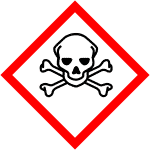
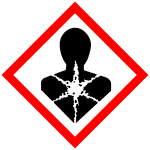
GHS06, GHS08 |
|---|---|
| 信号词 | Danger |
| 危害声明 | H300-H351 |
| 警示性声明 | P201-P202-P280-P301 + P310 + P330-P308 + P313-P501 |
| 个人防护装备 | Eyeshields;Faceshields;full-face particle respirator type N100 (US);Gloves;respirator cartridge type N100 (US);type P1 (EN143) respirator filter;type P3 (EN 143) respirator cartridges |
| 危害码 (欧洲) | T:Toxic |
| 风险声明 (欧洲) | R25;R40 |
| 安全声明 (欧洲) | S36/37-S45-S28A-S28 |
| 危险品运输编码 | UN 3462 6.1/PG 2 |
| WGK德国 | 3 |
| RTECS号 | CN0700000 |
| 包装等级 | II |
| 危险类别 | 6.1(a) |
Synonym:Ametycine Section 2 - COMPOSITION, INFORMATION ON INGREDIENTS
Risk Phrases: 25 33 Section 3 - HAZARDS IDENTIFICATION EMERGENCY OVERVIEW
Toxic if swallowed. Danger of cumulative effects. Potential Health Effects Eye: May cause eye irritation. Skin: May cause skin irritation. Ingestion: Harmful if swallowed. May cause liver damage. May cause digestive tract disturbances. May cause bone marrow depression. Inhalation: May cause respiratory tract irritation. May cause effects similar to those described for ingestion. May cause pulmonary fibrosis and permanent damage. Chronic: May cause cancer according to animal studies. Chronic exposure may cause liver damage. Adverse reproductive effects have been reported in animals. Potential cancer hazard. Section 4 - FIRST AID MEASURES Eyes: Flush eyes with plenty of water for at least 15 minutes, occasionally lifting the upper and lower eyelids. Get medical aid. Skin: Get medical aid. Flush skin with plenty of water for at least 15 minutes while removing contaminated clothing and shoes. Wash clothing before reuse. Ingestion: Do not induce vomiting. If victim is conscious and alert, give 2-4 cupfuls of milk or water. Never give anything by mouth to an unconscious person. Get medical aid. Inhalation: Remove from exposure and move to fresh air immediately. If not breathing, give artificial respiration. If breathing is difficult, give oxygen. Get medical aid. Do NOT use mouth-to-mouth resuscitation. Notes to Physician: Section 5 - FIRE FIGHTING MEASURES General Information: As in any fire, wear a self-contained breathing apparatus in pressure-demand, MSHA/NIOSH (approved or equivalent), and full protective gear. During a fire, irritating and highly toxic gases may be generated by thermal decomposition or combustion. Non-combustible, substance itself does not burn but may decompose upon heating to produce irritating, corrosive and/or toxic fumes. Extinguishing Media: In case of fire, use water, dry chemical, chemical foam, or alcohol-resistant foam. Substance is noncombustible; use agent most appropriate to extinguish surrounding fire. Section 6 - ACCIDENTAL RELEASE MEASURES General Information: Use proper personal protective equipment as indicated in Section 8. Spills/Leaks: Clean up spills immediately, observing precautions in the Protective Equipment section. Sweep up, then place into a suitable container for disposal. Avoid generating dusty conditions. Provide ventilation. Section 7 - HANDLING and STORAGE Handling: Wash thoroughly after handling. Remove contaminated clothing and wash before reuse. Use only in a well-ventilated area. Minimize dust generation and accumulation. Do not get in eyes, on skin, or on clothing. Keep container tightly closed. Do not ingest or inhale. Storage: Do not store in direct sunlight. Keep container closed when not in use. Store in a cool, dry, well-ventilated area away from incompatible substances. Hormones and antibiotics room. Store below 40C. Section 8 - EXPOSURE CONTROLS, PERSONAL PROTECTION Engineering Controls: Facilities storing or utilizing this material should be equipped with an eyewash facility and a safety shower. Use adequate general or local exhaust ventilation to keep airborne concentrations below the permissible exposure limits. Exposure Limits CAS# 50-07-7: CAS# 7647-14-5: Russia: 5 mg/m3 TWA Personal Protective Equipment Eyes: Wear safety glasses and chemical goggles if splashing is possible. Skin: Wear appropriate protective gloves and clothing to prevent skin exposure. Clothing: Wear appropriate protective clothing to minimize contact with skin. Respirators: A respiratory protection program that meets OSHA's 29 CFR 1910.134 and ANSI Z88.2 requirements or European Standard EN 149 must be followed whenever workplace conditions warrant respirator use. Section 9 - PHYSICAL AND CHEMICAL PROPERTIES Physical State: Crystalline powder Color: blue-violet Odor: None reported. pH: Not available. Vapor Pressure: Not available. Viscosity: Not available. Boiling Point: Not available. Freezing/Melting Point: > 360 deg C Autoignition Temperature: Not applicable. Flash Point: Not applicable. Explosion Limits, lower: Not available. Explosion Limits, upper: Not available. Decomposition Temperature: Solubility in water: soluble Specific Gravity/Density: Molecular Formula: C15H18N4O5 Molecular Weight: 334.32 Section 10 - STABILITY AND REACTIVITY Chemical Stability: Stable under normal temperatures and pressures. Conditions to Avoid: Incompatible materials, light, dust generation, excess heat, temperatures above 40C. Incompatibilities with Other Materials: Strong oxidizing agents - strong acids - strong bases. Hazardous Decomposition Products: Nitrogen oxides, carbon monoxide, carbon dioxide, nitrogen. Hazardous Polymerization: Has not been reported. Section 11 - TOXICOLOGICAL INFORMATION RTECS#: CAS# 50-07-7: CN0700000 CAS# 7647-14-5: VZ4725000 LD50/LC50: CAS# 50-07-7: Oral, mouse: LD50 = 23 mg/kg; Oral, rat: LD50 = 30 mg/kg. CAS# 7647-14-5: Draize test, rabbit, eye: 100 mg Mild; Draize test, rabbit, eye: 100 mg/24H Moderate; Draize test, rabbit, eye: 10 mg Moderate; Draize test, rabbit, skin: 50 mg/24H Mild; Draize test, rabbit, skin: 500 mg/24H Mild; Inhalation, rat: LC50 = >42 gm/m3/1H; Oral, mouse: LD50 = 4 gm/kg; Oral, rat: LD50 = 3000 mg/kg; Skin, rabbit: LD50 = >10 gm/kg. Carcinogenicity: Mitomycin C - California: carcinogen, initial date 4/1/88 IARC: Group 2B carcinogen Sodium chloride - Not listed by ACGIH, IARC, or NTP. Other: See actual entry in RTECS for complete information. Section 12 - ECOLOGICAL INFORMATION Section 13 - DISPOSAL CONSIDERATIONS Dispose of in a manner consistent with federal, state, and local regulations. Section 14 - TRANSPORT INFORMATION IATA Shipping Name: TOXIC SOLID, ORGANIC, N.O.S.* Hazard Class: 6.1 UN Number: 2811 Packing Group: II IMO Shipping Name: TOXIC SOLID, ORGANIC, N.O.S. Hazard Class: 6.1 UN Number: 2811 Packing Group: II RID/ADR Shipping Name: TOXIC SOLID, ORGANIC, N.O.S. Hazard Class: 6.1 UN Number: 2811 Packing group: II USA RQ: CAS# 50-07-7: 10 lb final RQ; 4.54 kg final RQ Section 15 - REGULATORY INFORMATION European/International Regulations European Labeling in Accordance with EC Directives Hazard Symbols: T Risk Phrases: R 25 Toxic if swallowed. R 33 Danger of cumulative effects. Safety Phrases: S 45 In case of accident or if you feel unwell, seek medical advice immediately (show the label where possible). WGK (Water Danger/Protection) CAS# 50-07-7: 3 CAS# 7647-14-5: 0 Canada CAS# 50-07-7 is listed on Canada's NDSL List. CAS# 7647-14-5 is listed on Canada's DSL List. CAS# 50-07-7 is not listed on Canada's Ingredient Disclosure List. CAS# 7647-14-5 is not listed on Canada's Ingredient Disclosure List. US FEDERAL TSCA CAS# 50-07-7 is listed on the TSCA inventory. CAS# 7647-14-5 is listed on the TSCA inventory. SECTION 16 - ADDITIONAL INFORMATION N/A |
|
~10% 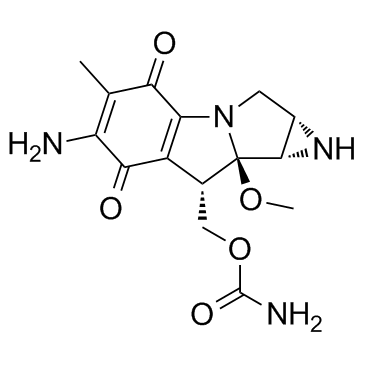
50-07-7 |
| 文献:Kasai; Kono; Ikeda; Yoda; Hirayama Journal of Organic Chemistry, 1992 , vol. 57, # 26 p. 7296 - 7299 |
|
~81% 
50-07-7 |
| 文献:Arai, Hitoshi; Kasai, Masaji Journal of Organic Chemistry, 1993 , vol. 58, # 15 p. 4151 - 4152 |
|
~73% 
50-07-7 |
| 文献:Kasai; Kono; Ikeda; Yoda; Hirayama Journal of Organic Chemistry, 1992 , vol. 57, # 26 p. 7296 - 7299 |
|
~% 
50-07-7 |
| 文献:Kasai; Kono; Ikeda; Yoda; Hirayama Journal of Organic Chemistry, 1992 , vol. 57, # 26 p. 7296 - 7299 |
|
~79% 
50-07-7 |
| 文献:Furuhata; Komiyama; Takeda; Takayanagi; Torii; Mishima; Ogura; Hata Chemical and Pharmaceutical Bulletin, 1989 , vol. 37, # 10 p. 2651 - 2654 |
|
~20% 
50-07-7
详细
|
| 文献:Vyas, D. M.; Chiang, Y.; Benigni, D.; Doyle, T. W. Journal of Organic Chemistry, 1987 , vol. 52, # 25 p. 5601 - 5605 |
|
~% 
50-07-7 |
| 文献:Senter; Pearce; Greenfield Journal of Organic Chemistry, 1990 , vol. 55, # 9 p. 2975 - 2978 |
|
~% 
50-07-7 |
| 文献:Chen; Coppola; Johns; Bogardus; Lipper Journal of Pharmaceutical Sciences, 1986 , vol. 75, # 2 p. 208 - 210 |
|
~% 
50-07-7 |
| 文献:Danishefsky; Ciufolini Journal of the American Chemical Society, 1984 , vol. 106, # 21 p. 6424 - 6425 |
| 上游产品 6 | |
|---|---|
| 下游产品 5 | |

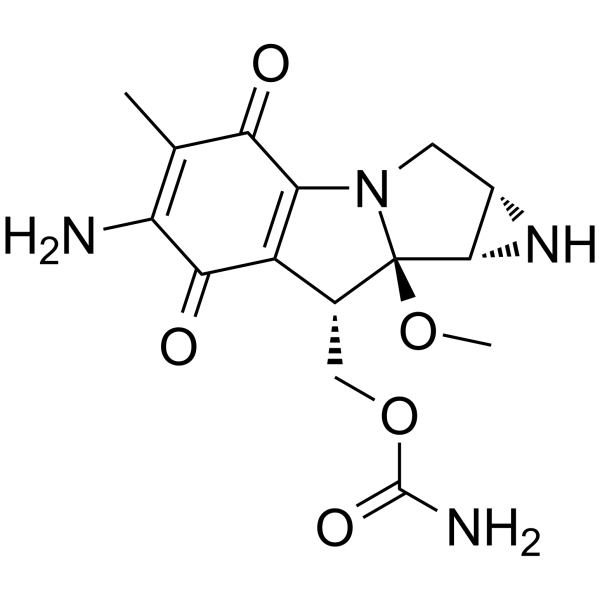
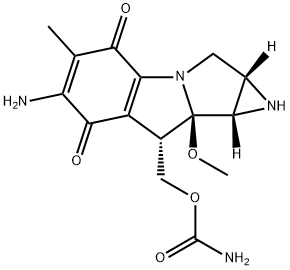

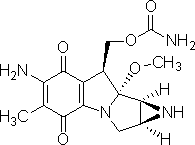
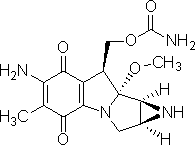
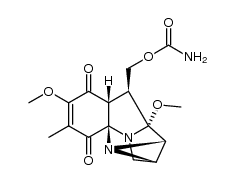
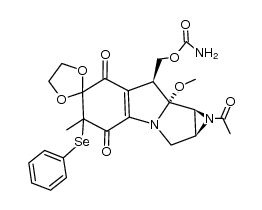
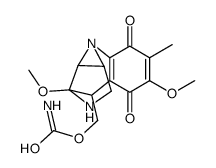
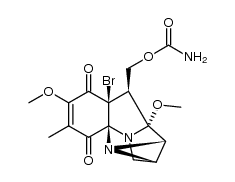

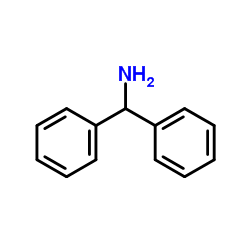
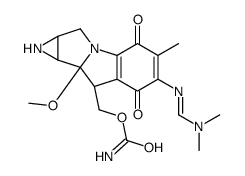
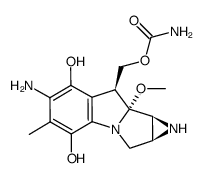
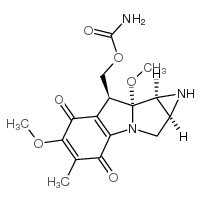
![Azirino[2',3':3,4]pyrrolo[1,2-a]indole-4,7-dione,8-[[(aminocarbonyl)oxy]methyl]-1,1a,2,8,8a,8b-hexahydro-8a-methoxy-5-methyl-6-(methylamino)-,[1aS-(1aa,8b,8aa,8ba)]- (9CI)结构式](/20230522/27066-44-0.png)
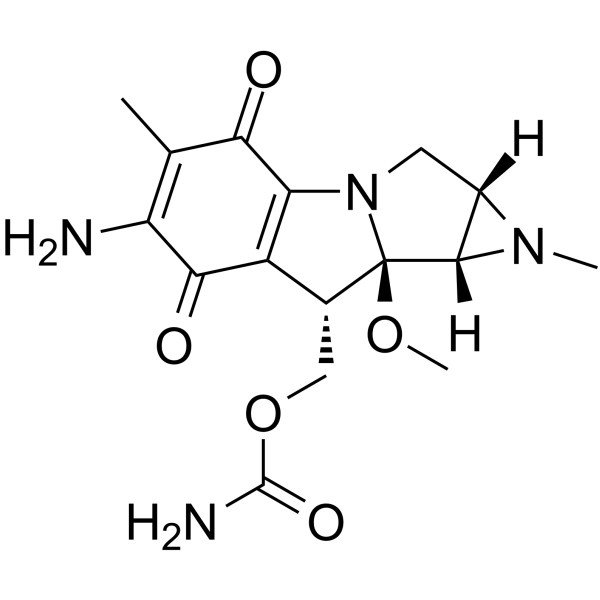
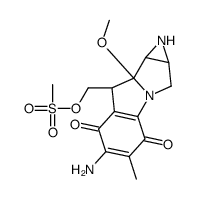
![Azirino[2',3'_3,4]pyrrolo[1,2-.α.]indole-4,7-dione, 1,1a,2,8,8a,8b-hexahydro-6-hydroxy-8-(hydroxymethyl)-8a-methoxy-5-methyl-, 8-carbamate结构式](/20230522/7041-61-4.png)





 浙公网安备 33010802013016号
浙公网安备 33010802013016号